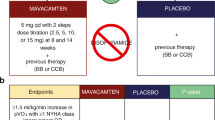Summary
We evaluated the effects of disopyramide in terms of the balance between myocardial oxygen supply and demand in patients with hypertrophic obstructive cardiomyopathy (HOCM). The myocardial oxygen supply was evaluated by measuring coronary flow velocity and the myocardial oxygen demand was assessed by the pressure-volume area (PVA). The time velocity integral of coronary flow did not change significantly (20±6 to 21±8 cm), but the peak left ventricular pressure and left ventricular external work decreased significantly (206±44 to 157±37 mmHg,P<0.001; 1.09±0.33 to 0.80±0.23 J/beat,P<0.001) after disopyramide administration. From theoretical analysis using these data, we concluded that disopyramide improves the myocardial oxygen supply-demand balance in patients with HOCM.
Similar content being viewed by others
References
Pollick C (1982) Muscular subaortic stenosis: hemodynamic and clinical improvement after disopyramide. N Engl J Med 307:997–999
Duncan WJ, Tyrrell MJ, Bharadwaj BB (1991) Disopyramide as a negative inotrope in obstructive cardiomyopathy in children. Can J Cardiol 7:81–86
Millaire A, Goullard L, Decoulx E, de Groote P, Houdas Y, Ducloux G (1992) Efficiency of disopyramide in hypertrophic cardiomyopathy during stress states. Am J Cardiol 69:423–424
Kimball BP, Bui S, Wigle ED (1993) Acute dose-response effects of intravenous disopyramide in hypertrophic obstructive cardiomyopathy. Am Heart J 125:1691–1697
Matsubara H, Nakatani S, Nagata S, Ishikura F, Katagiri Y, Ohe T, Miyatake K (1995) Salutary effect of disopyramide on left ventricular diastolic function in hypertrophic obstructive cardiomyopathy. J Am Coll Cardiol 26:768–775
Pollick C, Kimball B, Henderson M, Wigle ED (1988) Disopyramide in hypertrophic cardiomyopathy. I. Hemodynamic assessment after intravenous administration. Am J Cardiol 62:1248–1251
Suga H, Hayashi T, Suehiro S, Hisano R, Shirahata M, Ninomiya I (1981) Equal oxygen consumption rates of isovolumic and ejecting contractions with equal systolic pressure-volume areas in canine left ventricle. Circ Res 49:1082–1091
Suga H, Hayashi T, Shirahata M (1981) Ventricular systolic pressure-volume area as predictor of cardiac oxygen consumption. Am J Physiol 240:H39-H44
Suga H (1990) Ventricular energetics. Physiol Rev 70:247–277
Kameyama T, Asanoi H, Ishizaka S, Yamanishi K, Fujita M, Sasayama S (1992) Energy conversion efficiency in human left ventricle. Circulation 85:988–996
Takaoka H, Takeuchi M, Odake M, Yokoyama M (1992) Assessment of myocardial oxygen consumption (Vo2) and systolic pressure-volume area (PVA) in human hearts. Eur Heart J 13(Suppl E):85–90
Takaoka H, Takeuchi M, Odake M, Hayashi Y, Hata K, Mori M, Yokoyama M (1993) Comparison of hemodynamic determinants for myocardial oxygen consumption under different contractile states in human ventricle. Circulation 87:59–69
Hayashi Y, Takeuchi M, Takaoka H, Hata K, Mori M, Yokoyama M (1996) Alteration in energetics in patients with left ventricular dysfunction after myocardial infarction: Increased oxygen cost of contractility. Circulation 93:932–939
Yamakawa H, Takeuchi M, Takaoka H, Hata K, Mori M, Yokoyama M (1996) Negative chronotropic effect of β-blockade therapy reduces myocardial oxygen expenditure for nonmechanical work. Circulation 94:340–345
Pierce GE, Morrow AG, Braunwald E (1964) Idiopathic hypertrophic subaortic stenosis III. Circulation 30[Suppl 4]:152–174
Murgo JP, Alter BR, Dorethy JF, Altobelli SA, McGranahan GJ (1980) Dynamics of left ventricular ejection in obstructive and nonobstructive hypertrophic cardiomyopathy. J Clin Invest 66:1369–1382
Maron BJ, Gottdiener JS, Arce J, Rosing DR, Wesley YE, Epstein SE (1985) Dynamic subaortic obstruction in hypertrophic cardiomyopathy: Analysis by pulsed Doppler echocardiography. J Am Coll Cardiol 6:1–18
Eckenhoff JE, Hafkenschiel JH, Landmesser CM, Harmel M (1947) Cardiac oxygen metabolism and control of the coronary circulation. Am J Physiol 149:634–649
Hongo M, Nakatsuka T, Takenaka H, Tanaka M, Watanabe N, Yazaki Y, Sekiguchi M (1996) Effects of intravenous disopyramide on coronary hemodynamics and vasodilator reserve in hypertrophic obstructive cardiomyopathy. Cardiology 87:6–11
Author information
Authors and Affiliations
Rights and permissions
About this article
Cite this article
Niki, K., Sugawara, M., Asano, R. et al. Disopyramide improves the balance between myocardial oxygen supply and demand in patients with hypertrophic obstructive cardiomyopathy. Heart Vessels 12, 111–118 (1997). https://doi.org/10.1007/BF02767128
Received:
Revised:
Accepted:
Issue Date:
DOI: https://doi.org/10.1007/BF02767128




